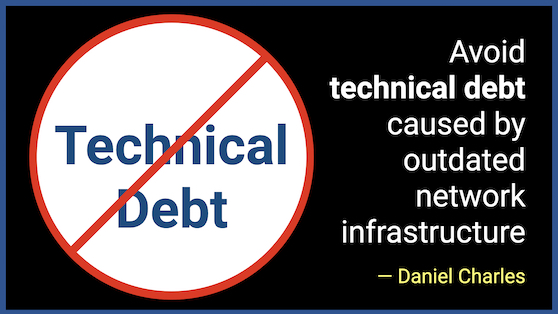
Commercial
Features
Industrial
Institutional
Avoid “technical debt” caused by outdated network infrastructure
September 29, 2020 By Daniel Charles

September 29, 2020 – Forrester Research says that maintaining outdated applications and technology now consumes 70% or more of an organization’s technology budget. That’s a large chunk of money! The time, money and effort it takes to keep these systems running can lead to technical debt.
The term “technical debt” has its roots in IT, code and programming. It is used to describe the implied costs of rework caused by poor performance. At its core, technical debt refers to cutting corners: taking actions to accelerate delivery without any consideration for long-term performance or reliability. This approach may appease short-term requirements and get you to completion faster, but it often results in more work later when systems have to be revisited due to repairs, compatibility problems, performance issues, failure, etc.
Technical debt is a concept that can apply to cabling infrastructure, too. Legacy cabling systems and installation processes can drain money, time and resources, as well as prevent organizations from staying competitive and achieving digital transformation. Also, when you don’t have the cabling and connectivity to support emerging technology, you won’t be able to move your business forward.
Just like financial debt, technical debt involves two types of expenses: principal and interest:
• Principal = the cost of fixing problems
• Interest = the cost of the inefficiencies caused by those problems
Technical debt can really spiral out of control when you cut corners and delay making necessary fixes. A lot of money and manpower goes toward makeshift solutions instead of innovative initiatives to propel an organization forward.
During the decision-making process, some see technical debt as being offset by the benefits associated with finishing the work faster (e.g. saving money, sticking to the timeline, being first to market, etc.). But technical debt does bring forward a host of problems:
• You’ll spend more time on fixes rather than working on new features or critical updates.
• Total cost of ownership increases due to the extra time and work going into maintenance and service.
• You’ll potentially experience unplanned downtime… and it will take longer to determine the root cause.
• Simple tasks will take much longer than they should.
• Scalability and new technology will become much more difficult to implement.
Think of it this way: when you invest in a new roof, it may be tempting to cut corners by using fewer nails than the manufacturer recommends. Using fewer nails means the installer will save time, money and manpower. The roof will be completed faster, and everything will probably seem fine at first. But what happens in a few years?
Over time, wind, snow and rain will get under your shingles and create bigger problems. At some point, those problems will need to be addressed, costing you more time and money. Had the job been done right the first time, using the right materials, you wouldn’t have to spend the time and money to correct these problems.

Similarly, an okay cabling infrastructure may seem stable for a while, but it won’t last forever. It can be difficult to respond to—and recover from—sudden failure or unplanned downtime.
More than ever, companies cannot afford to rely on a failing infrastructure. When cabling systems fail, so do all the systems, applications and technology that rely upon them.
When it comes to cabling and connectivity, technical debt can increase by:
• Creating a spaghetti mess of cable that will, at some point, have to be organized.
• Making racks and PDUs difficult to access.
• Selecting infrastructure solutions that support what you’re doing right now without considering the technology and applications you’ll use five years from now.
• Selecting a cable that isn’t recommended for your application.
• Choosing lower-grade patch cords to save money.
Plan for the future to lower your debt
We’re at the dawn of new frontier. Technology will have a major impact on workforce productivity. Network speeds for wired connections have increased to 10 Gb/s. With the unveiling of IEEE 802.11ax, wireless connectivity is also headed toward 10 Gb/s. Cabling and connectivity need to support these new technologies and applications; otherwise, technical debt can accrue.
Investing in quality and reliability over cheap and fast helps you reduce technical debt and, yes, there are ways to save time and money while still doing things the right way.
To stay ahead of technical debt, plan for the future now, and consider the impact of your decisions. Resist the urge to put “cut costs” at the top of your list. When you place efficiency, productivity and reliability at the top instead, the cost savings will come naturally in the form of time savings, consistent uptime and fewer problems.
Daniel Charles is currently one of Belden’s global product managers for copper connectivity, but has served in a variety of product specialist roles during his 6 years with the company. Daniel graduated from HEC Montréal in 2011 with a degree in operations management and international business. He can be reached at daniel.charles@belden.com.
Print this page